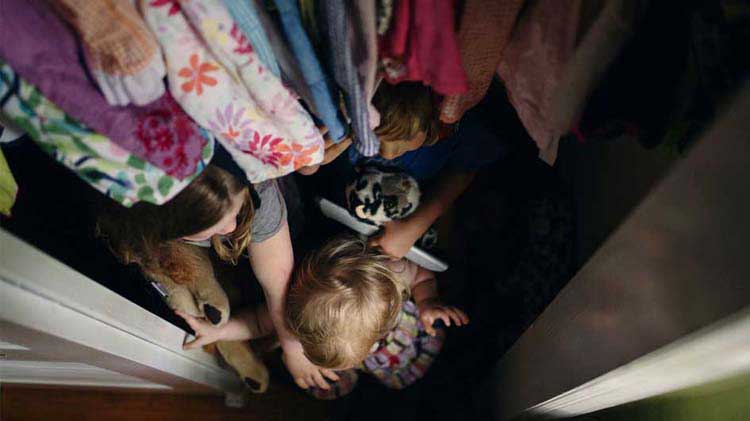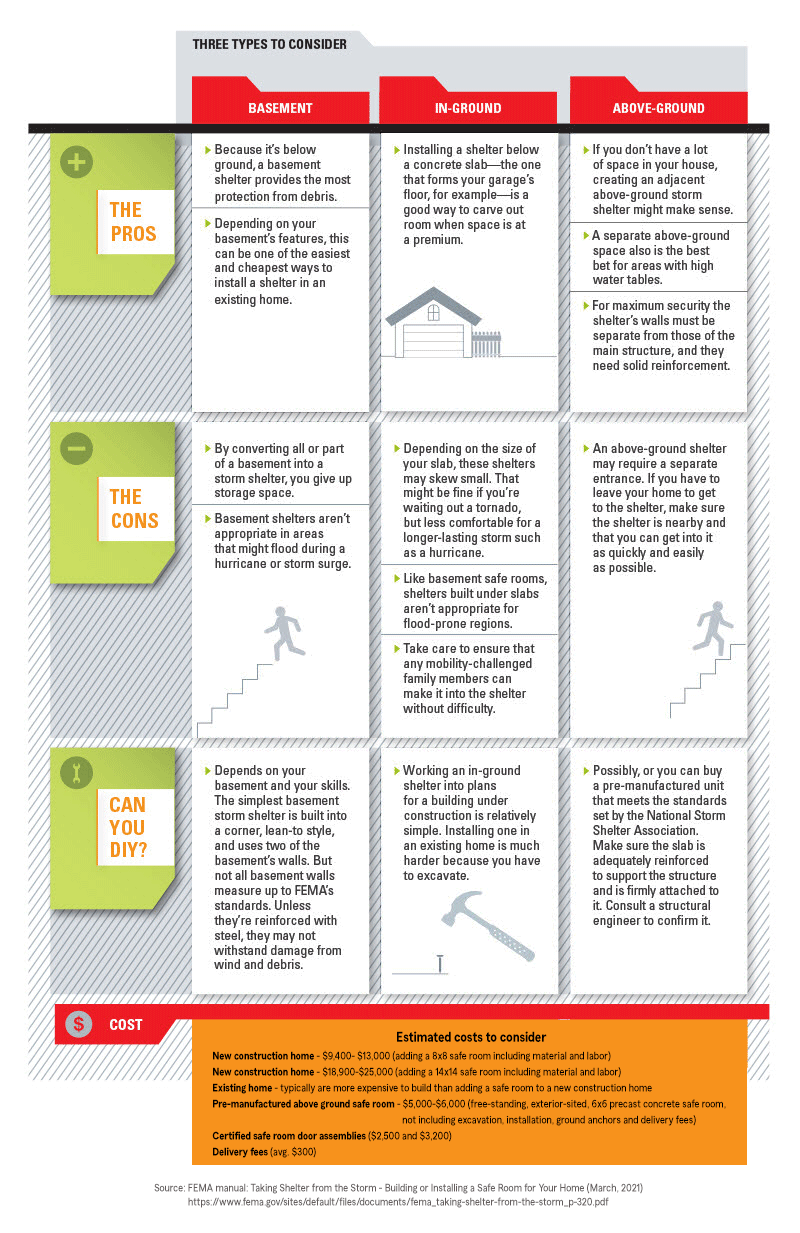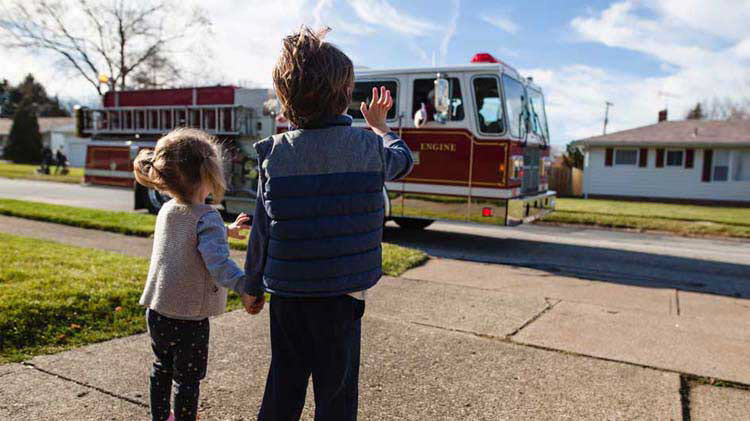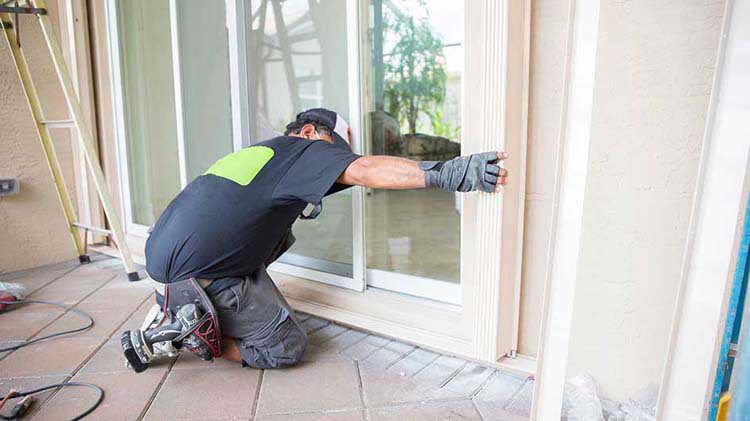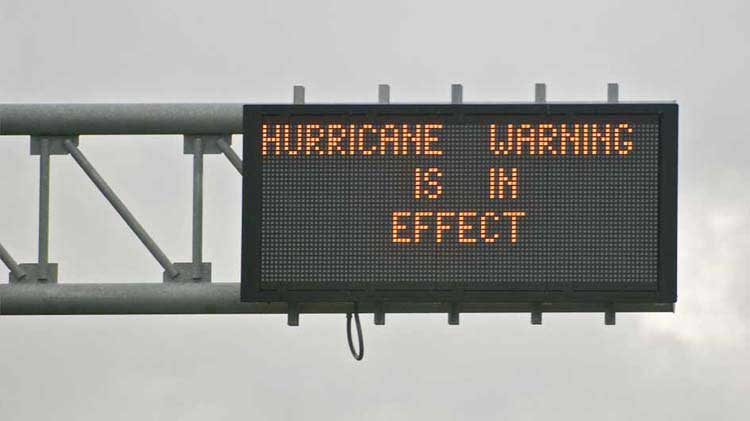How a storm shelter or safe room can help protect against severe weather
Constructing a storm shelter space within your home can help protect you from natural disasters and weather emergencies.
During severe weather, natural disasters and severe wind events, having a safe and secure place to go is important. Disaster-preparedness guides often instruct you to head to your basement, but not all homes have that option, and it is not always the safest option due to the possibility of broken windows, flying debris and the potential for flooding. Storm shelters and safe rooms can help provide life-saving protection from severe winds and tornadoes. Most shelters are constructed in a basement, above-ground, or in-ground.
How a safe room protected one family
Kevin and Sarabeth Harrison, with their two children, huddled inside a safe room that Kevin and his father built inside their detached garage. After the storm, the garage was gone. The only thing left standing was their safe room. This Alabama family survived the massive tornado strike that ripped through their Athens neighborhood, killing nearly 250 people. For this family, having a safe room protected them from the dangerous forces of nature.
Should I build a storm shelter?
Storm shelters or storm cellars are usually underground and designed to protect people and pets from violent weather and tornadoes. Shelters are most often seen in Southeastern and Midwest areas of the United States where tornadoes are frequent, and a low water table allows underground structures. Storm shelters have proven, historically, to be a practical and safe addition for homeowners or property owners.
Some shelters are built onto or within a home, and some are built on a homeowner's property. A suitable shelter depends on your location, the size of your family and your home's condition. For example, if you're in an area with a high risk of hurricanes, consider a larger shelter because you may have to wait out the storm for hours, whereas tornadoes pass by relatively quickly.
Should I build a safe room?
A safe room is an area in your home that is reinforced to provide protection from debris, broken glass and other hazards. Many people design and construct a safe room as part of their disaster preparedness plan and emergency plan for their residence.
How are safe rooms constructed?
Generally, safe rooms are either built onto an existing home or included in new home construction. There are pre-manufactured safe rooms that can be added, as well. The safe room plans, researched by Texas Tech University, come in a variety of designs for rooms in the basement and rooms on the main floor for homes without basements. Safe rooms are typically built out of reinforced concrete, reinforced concrete block or wood-framed walls with plywood and steel sheathing. The room is covered with a similar structural ceiling/roof that is independent of the house structure. Everything is tied down to the foundation from the top of the safe room to resist the uplift forces generated during a tornado or hurricane. The exterior materials and structure of the safe room are impact resistant to protect the occupants from wind-borne debris.
What costs are involved?
The costs involved depend on the design. The Federal Emergency Management Agency (FEMA) has developed a manual that includes design plans titled "Taking Shelter from the Storm: Building or Installing a Safe Room for Your Home." This manual includes plans for a family shelter space for use in the event of a natural disaster and also includes estimates of the cost to order or construct one. All plans have details and a materials list. The plans can be given to a contractor for estimates.
Homeowners can build or retrofit the interior spaces of their homes to safe-room standards or choose to buy prefabricated safe rooms designed to withstand tornado-force winds. Closets, bathrooms, laundry rooms and outdoor rooms like garden sheds and pool houses can also be enhanced to serve as safe rooms.
Site-built safe room costs
According to FEMA's plans, when a safe room is built during the construction of a new home, the estimated basic cost including materials, contingency costs and labor to construct a standard shelter space ranges from $9,400 to $13,100 for an 8-foot × 8-foot space. Costs range from an estimated $18,900 to $25,500 for a 14-foot × 14-foot space. The basic cost does not include the cost and installation of the safe room door assembly. Certified safe room door assemblies that are properly tested and labeled residential safe room door assemblies, are between approximately $2,500 and $3,200.
Retrofitting a shelter or safe room in an existing home tends to cost more than adding them onto new construction homes. As is the case with new construction, the cost is contingent upon several variables including the size and location of the space being built.
According to FEMA, the estimated cost of a shelter or safe room will vary depending on a variety of factors, including:
- Size and location of the room or shelter,
- Whether you are building a safe room in a new home or retrofitting an existing home,
- Construction materials (concrete, wood, insulated concrete form),
- Type of foundation on which the house is built,
- Excavation costs,
- Depth of footing (cost estimates are based on a minimum depth of 2 feet, 6 inches),
- The geographic location within the United States (regional variations in labor and material costs),
- Added amenities (e.g., bathroom fixtures), and
- Installation of the safe room door assembly.
Pre-manufactured safe room costs
Pre-manufactured safe rooms typically cost less than site-built safe rooms and are available in smaller sizes than the designs FEMA has proposed. This type is typically installed outside the home and some are in-ground. Costs involved include the unit, delivery, labor and any foundation or geotechnical work that may be needed to install the unit. If a supporting foundation is needed, the average cost of site preparation is $1,000, which includes a reinforced concrete slab for anchoring.
According to FEMA, a free-standing, exterior-sited, 6-foot × 6-foot precast concrete safe room may be installed for approximately $5,700. In-ground safe room options, which are installed outside of the house, are available in precast concrete and steel. Small steel in-ground units typically cost between $5,000 and $6,000, which does not include the excavation, installation, ground anchors and delivery fees.
Do it yourself or hire a contractor?
If you decide to build one yourself, make sure you plan and understand the costs and time involved, and that the room or shelter meets all applicable FEMA standards. If you plan on hiring the work, the National Association of Home Builders offers tips when looking for a professional contractor. Always be aware of common contractor scams.
Pros and Cons to consider for your safe room plans
The infographic in this article provides a list of some of the pros and cons for adding a storm shelter or safe room to a basement, installing in-ground or above-ground.
The FEMA FAQ guide may help answer some additional questions about safe rooms.
When a weather emergency hits, having an emergency plan and your emergency kits are important. Always make sure your home insurance coverages are up to date and contact an agent if you have any questions. Also, State Farm customers impacted by severe weather can always call 800-732-5246, contact their agent or file a claim online.
